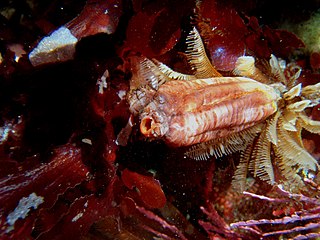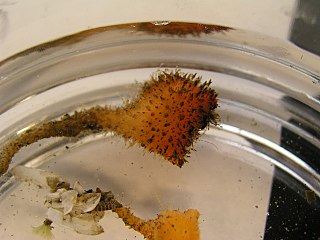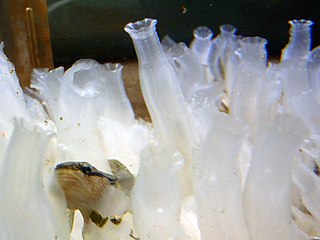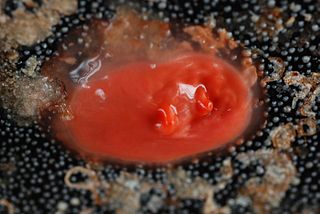
A tunicate is a marine invertebrate animal, a member of the subphylum Tunicata. It is part of the Chordata, a phylum which includes all animals with dorsal nerve cords and notochords. The subphylum was at one time called Urochordata, and the term urochordates is still sometimes used for these animals. They are the only chordates that have lost their myomeric segmentation, with the possible exception of the 'seriation of the gill slits'. However, doliolids still display segmentation of the muscle bands.

Ascidiacea, commonly known as the ascidians or sea squirts, is a paraphyletic class in the subphylum Tunicata of sac-like marine invertebrate filter feeders. Ascidians are characterized by a tough outer "tunic" made of a polysaccharide.

Corella willmeriana is a solitary tunicate in the family Corellidae. It is native to the eastern Pacific Ocean where it lives on the seabed at depths down to about 75 m (250 ft) between Alaska and California.

Styela montereyensis, also called the stalked tunicate, Monterey stalked tunicate, and the long-stalked sea squirt is a solitary ascidian tunicate. It has a cylindrical, yellow to dark reddish-brown body and a thin trunk that anchors it to rocks. It is found in subtidal areas of the western coast of North America from Vancouver Island to Baja California.

Ecteinascidia turbinata, commonly known as the mangrove tunicate, is a species of sea squirt species in the family Perophoridae. It was described to science in 1880 by William Abbott Herdman. The cancer drug trabectedin is isolated from E. turbinata.

Atriolum robustum is a colonial tunicate or sea squirt in the family Didemnidae. It is native to the western and central Indo-Pacific where it is usually found anchored to a hard surface in shallow water.

Polycarpa aurata, also known as the ox heart ascidian, the gold-mouth sea squirt or the ink-spot sea squirt, is a species of tunicate in the family Styelidae.

Didemnum molle is a species of colonial tunicate in the family Didemnidae. It is commonly known as the tall urn ascidian, the green barrel sea squirt or the green reef sea-squirt. It is native to the Red Sea and the tropical waters of the Indo-Pacific region.

Didemnum vexillum is a species of colonial tunicate in the family Didemnidae. It is commonly called sea vomit, marine vomit, pancake batter tunicate, or carpet sea squirt. It is thought to be native to Japan, but it has been reported as an invasive species in a number of places in Europe, North America and New Zealand. It is sometimes given the nickname "D. vex" because of the vexing way in which it dominates marine ecosystems when introduced into new locations; however, the species epithet vexillum actually derives from the Latin word for flag, and the species was so named because of the way colonies' long tendrils appear to wave in the water like a flag.

Ciona savignyi is a marine animal sometimes known as the Pacific transparent sea squirt or solitary sea squirt. It is a species of tunicates in the family Cionidae. It is found in shallow waters around Japan and has spread to the west coast of North America where it is regarded as an invasive species.
Perophora viridis, the honeysuckle tunicate, is a species of colonial sea squirt in the genus Perophora found in the tropical western Atlantic Ocean.

Polycarpa pomaria is a species of tunicate or sea squirt in the family Styelidae. It is native to the northeastern Atlantic Ocean where it lives on the seabed at depths down to about 450 metres (1,500 ft).

Dendrodoa grossularia is a species of tunicate or sea squirt in the family Styelidae, commonly known as the baked bean ascidian. It is native to the northeastern Atlantic Ocean where it is common in shallow water and on the lower shore in exposed rocky sites.
Stolonica socialis is a species of tunicate or sea squirt in the family Styelidae, commonly known as orange sea grapes. It is native to the northeastern Atlantic Ocean, where it lives on the rocky seabed in shallow water.

Corella is a genus of sea squirts belonging to the family Corellidae. The genome of Corella inflata has been sequenced which has provided insight into tunicate evolution

Boltenia villosa is a species of tunicate, a marine invertebrate of the family Pyuridae. Common names include spiny-headed tunicate, hairy sea squirt, stalked hairy sea squirt and bristly tunicate. This species was first described in 1864 by the American marine biologist William Stimpson who gave it the name Cynthia villosa. It was later transferred to the genus Boltenia. The type locality is Puget Sound, Washington state, United States.

Ciona robusta is a species of marine invertebrate in the genus Ciona of the family Cionidae. The holotype was collected on the northeastern coast of Honshu Island, Japan. Populations of Ciona intestinalis known as Ciona intestinalis type A found in the Mediterranean Sea, the Pacific Ocean, east coast of North America, and the Atlantic coasts of South Africa have been shown to be Ciona robusta.

Cnemidocarpa finmarkiensis is a species of solitary ascidian tunicate in the family Styelidae. Common names include broad base sea squirt, orange sea squirt, red sea squirt, shiny orange sea squirt, shiny red tunicate and Finmark's tunicate. It is native to shallow waters in the northern and northeastern Pacific Ocean.

Pyura haustor is a species of sessile ascidian, or sea squirt, that lives in coastal waters in the north-eastern Pacific Ocean, attached to rocks or artificial structures. Common names for this species include the wrinkled seapump, the wrinkled sea squirt and the warty tunicate.

Halocynthia igaboja, commonly known as sea hedgehog, bristly tunicate or spiny sea squirt, is a species of tunicate in the family Pyuridae. It is native to the northeastern Pacific Ocean. This species was first described in 1906 by the Japanese marine biologist Asajiro Oka, who gave it the name Cynthia ritteri. It was later transferred to the genus Halocynthia.


















